 This will be her first pillion trip so I'll be taking it easy, varying roads and accommodation. Hopefully all goes well and this will become a more regular thing.
This will be her first pillion trip so I'll be taking it easy, varying roads and accommodation. Hopefully all goes well and this will become a more regular thing.  This trip will run over 12 days and 4 provinces.
This trip will run over 12 days and 4 provinces.
This will be a running Ride Report updated as we go along. Hopefully I will be able to update it daily.
October is the month of my wife’s birthday and our wedding anniversary (12 years). To celebrate this we usually go on a trip which includes a show at Sun City.
This year we decided to take the bike and do a trip which would include Sun City, visiting family and attending the National Karate Championships in Bloemfontein where our son will be competing. Accommodation will include relatives & friends’ lodgings, B&B's, hotels and camping. I will try and meet up with other Wild Dogs in the towns we visit and hopefully ride with them and share a beer or two.
The route also runs past some historic sites of the Boer War I hope to visit. I’ve been wanting to see these and will incorporate the history of the war / battle fields as we visit them. These quotes will be in blue.
The Boer War :
The Boer War was fought from 11 October 1899 until 31 May 1902, between the British Empire and the two independent Boer republics of the Orange Free State and the South African Republic (Transvaal Republic). The Boers raided targets such as British troop columns, telegraph sites, railways and storage depots. In an effort to cut off supplies to the raiders, the British, under the leadership of Lord Kitchener, responded with a scorched earth policy of destroying Boer farms and moving civilians into concentration camps. The campaign had been expected by the British government to be over within months, but the protracted war became increasingly unpopular - especially after revelations about the conditions in the concentration camps (where thousands died of disease and malnutrition). The demand for peace led to a settlement of hostilities in 1902. The two republics were absorbed into the British Empire, although the British were forced to make a number of concessions and reparations to the Boers. The granting of limited autonomy for the area ultimately lead to the establishment of the Union of South Africa. The war, known as the last British imperial war, was the longest (almost three years), the most expensive (over £200 million) and the most disastrous of all wars for Britain between 1815 and 1914.
So, with this background I leave you to hopefully update Day 1 of this Ride Report in a day or two.
Tomorrow, if all goes well, we will be visiting Retired Springbok rugby player Mannetjies Roux's B&B in Victoria West.
Day 1
And so it begins...

Since this trip would consist of a lot of tarred roads I changed the Continental TKC tyres to Metzler Tourances. Rumour has it that the TKC's doesn't like weight and tar to much.

We left early to try and avoid an approaching cold front and rainy weather. Everything was fine when we left, but barely 15 minutes later on Outeniqua Pass we could see the cold front was moving in with a vengeance.

We hightailed it to De Rust where we had breakfast. Interesting sights and sounds in these small towns:
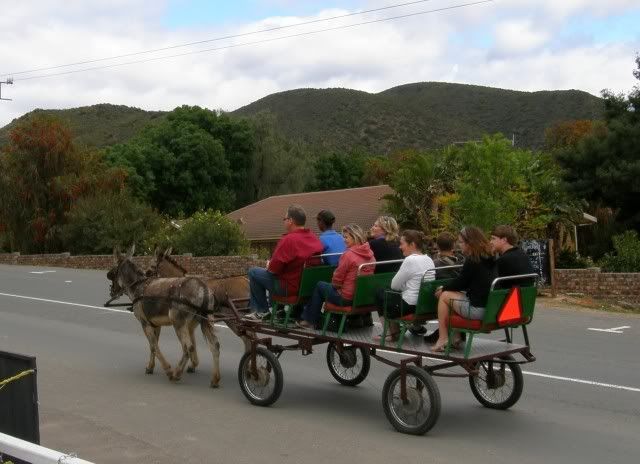
While having breakfast another couple on a bike bike pulled up. They were on day 10 of their trip and on their way home to Somerset West (right into the cold front
 ). This is what I like about bikes - if they pulled up by car and we where there by car we'd hardly notice each other, but because we were both on bikes we instantly started chatting and even had breakfast together. Really cool people.
). This is what I like about bikes - if they pulled up by car and we where there by car we'd hardly notice each other, but because we were both on bikes we instantly started chatting and even had breakfast together. Really cool people. Anyway, they were on a Harley and the owner was addament that he's buying a GS when he gets home. There were stuff they wanted to see (like the Owl House in Nieu Bethesda) but couldn't because they'd have to ride on gravel. In this country you miss out on so much if you don't do gravel roads.

Say what you want. This is a cool bike!

Meanwhile we got a phone call from my dad in George. It was raining cats & dogs. Time to move on...
Next up - the magnificent Meirings Poort. With the benefit of in-ride shots!

We saw this bloke, but not the speed trap...

(Just kidding
 )
)

We got some really cool in-ride video too. I will upload this when we get home.
Through Meirings Poort and into the Great Karoo it seemed like we outran the Cold Front. We did have a nasty side wind though. It was like going around a 100km bend, leaning into the wind all the time.
This stretch is straight as an arrow for miles on end.
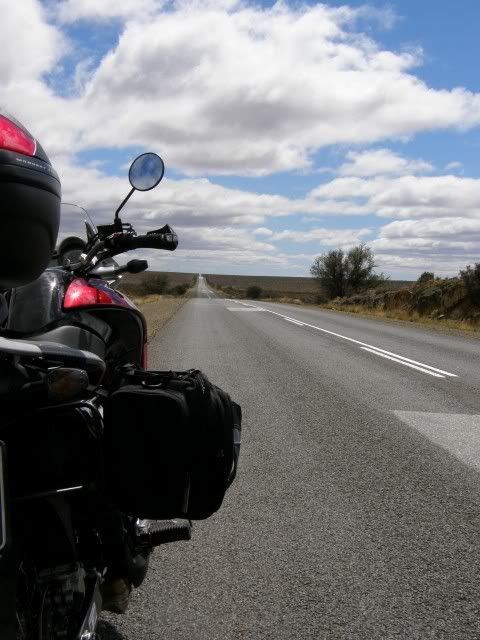
The map really gives some perspective. Straight North for about a 3rd of the distance travelled today.
(Interactive map - use your mouse or the arrows top
left to move & zoom in/out)
Me doing my Straatvalk (Streethawk) impression
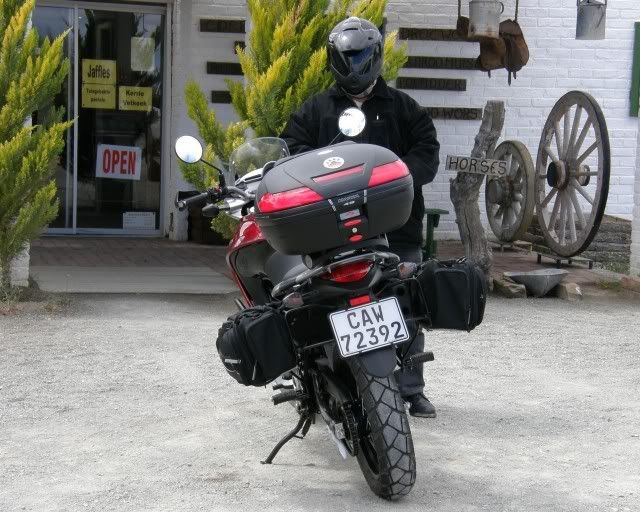
Refuel in Beaufort West (17,8 km/L two up with luggage) and on to 3 Sisters.



And finally we rolled into our destination for the day, Victoria West, at 2 pm (much earlier than expected).

This of course meant that we had lots of time to explore. What an interesting town!

Most of the roads are still gravel (

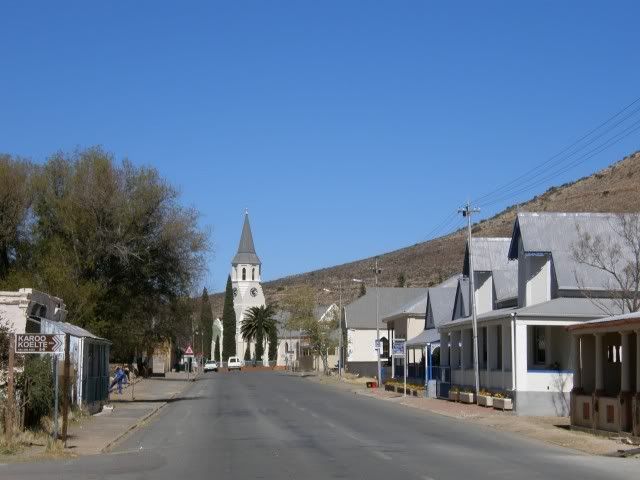

Victoria West even has a bike shop!

With a GS for sale

Word has it the previous owner bought a TA700 instead

Pity that Harley owner didn't know about this. Maybe he could get a trade in?

The Apollo Theater is also situated here. It's an old school theater that hosts the annual amateur film festival which, as luck would have it, started today!

Only R2 a ticket

But unfortunately this was opening night with cocktails and invited guests only
 Oh well, next time.
Oh well, next time.Last, but not least, the Victoria Trading post. This is the reason why I chose to stay over in Victoria West. This shop belongs to the Springbok Rugby Legend Mannetjies Roux.


I am a big Rugby fan and since my dad was involved with the Griqualand West Rugby Union the same time as Mannetjies I'm a big fan of him as well (who isn't?).
Mannetjies Roux
"Mannetjies" Roux (born 12 April 1939) is a former South African rugby player. He was capped 27 times; 6 times at wing and 21 times at centre, scoring 6 tries.
He won his first cap, at wing, against Wales in Cardiff in 1960, which the Springboks won 3-0 thanks to a Keith Oxlee penalty. He possessed a great deal of pace and was a ferocious defender, despite his lack of size. He was perhaps best known for his tackle on England and British Lions flyhalf Richard Sharp which broke Sharp's jaw or cheekbone (sources vary).
Controversy seemed to follow him almost throughout his career, with Roux achieving notoriety on the demo-ridden 1969/70 Springbok tour of the United Kingdom for kicking one protester in the backside and hurling the ball at another.
Retiring in 1970, after he led Griqualand West to only their third Currie Cup title to date (having also represented Western Province at the start of his career, in addition to Northern Transvaal), he eventually returned to the town of his birth. (Statistics)
"Mannetjies" Roux (born 12 April 1939) is a former South African rugby player. He was capped 27 times; 6 times at wing and 21 times at centre, scoring 6 tries.
He won his first cap, at wing, against Wales in Cardiff in 1960, which the Springboks won 3-0 thanks to a Keith Oxlee penalty. He possessed a great deal of pace and was a ferocious defender, despite his lack of size. He was perhaps best known for his tackle on England and British Lions flyhalf Richard Sharp which broke Sharp's jaw or cheekbone (sources vary).
Controversy seemed to follow him almost throughout his career, with Roux achieving notoriety on the demo-ridden 1969/70 Springbok tour of the United Kingdom for kicking one protester in the backside and hurling the ball at another.
Retiring in 1970, after he led Griqualand West to only their third Currie Cup title to date (having also represented Western Province at the start of his career, in addition to Northern Transvaal), he eventually returned to the town of his birth. (Statistics)

The museum also still has the actual leather rugby ball that was used when Griqualand West (whom Mannetjies captained at the time) won the Currie Cup for the third time in a final against the Northen Transvaal in 1970.


The cartoon in the paper when the British Lions came to tour South Africa way back when:

In addition to the shop (and his farm) they also run a B&B where we would stay over.
It's a great place, real value for money and I highly recommend it.

Mrs TR loved it!



And the man himself:

We tend to just ride or drive through these towns, but they have so much to offer. This being the area where SA's prime mutton comes from we had a nice braai with some choice Karoo Lamb for dinner.
Tomorrow we continue North. Who knows what secrets and gems the next day will bring.

Day 2
We woke to a brilliant day. Pleasant temperatures and no wind. The plan was to travel North, popping into every town to have a look around and also see some of the sites of the Anglo Boer War.
Typical Karoo scenery:

Britstown:

Funny how some of these little towns seem to flourish (like Victoria West) and others seem to be dying a slow death. What makes the difference?

Some more Karoo scenery:




Belmont & Graspan
When the war broke out, one of the Boers' early targets was the diamond-mining centre of Kimberley.
Lord Methuen’s task with his division was to force his way north up the railway to raise the Boer siege of Cecil Rhodes’s diamond town, Kimberley. Arriving at Belmont station it was apparent that the Boers were in position on the range of Belmont hills behind the road to the North.
Size of the armies: 8,000 British against 2,000 Boers from the Transvaal and the Free State.
The Boers opened fire on the exposed lines of Guardsmen stretching across the open ground at the bottom of the hillside. The 9th Brigade also found themselves in open veldt when dawn broke. The two brigades launched their attack from the open ground up onto the hills under heavy rifle fire from the Boers entrenched on the crest. The Boers did not wait for the final bayonet attack, hurrying away down the far hillside to where their ponies were tethered and riding back to the next line of hills, pursued for some distance by a small force of 9th Lancers and Mounted Infantry.
Following the battle for Belmont the Boers fell back to the next station on the line, Graspan, where the fighting was similar in pattern. The way was now open for Methuen to reach the Modder River; within striking distance of Kimberley.
Casualties: British casualties at Belmont were 200 and at Graspan 197. Boer casualties at each battle are unknown but are thought to have been slight.
Belmont:

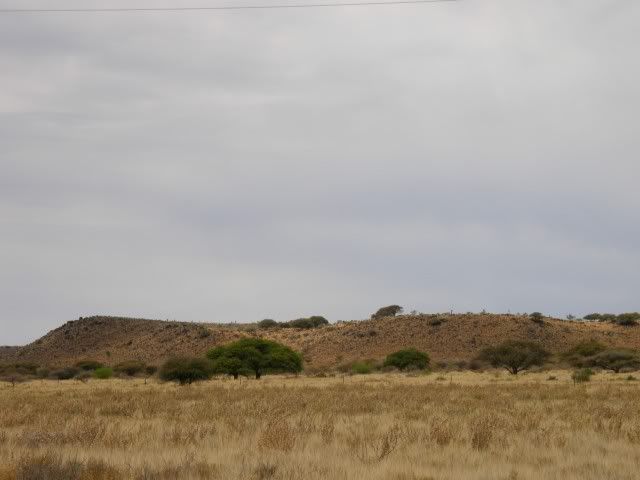
This is why I like to read about the places we're going to visit. This would just be another "koppie" in the Karoo if you don't know what happened here.
Graspan:


Battle of Modder River
Size of the armies: 8,000 British against 9,000 Boers.
The Boers under General Piet Cronje had been reinforced by a substantial contingent from the Transvaal under General Koos de la Rey, who proposed a radical new plan of defence.
Methuen's force consisted of two infantry brigades, two mounted regiments, three batteries of field artillery (18th, 62nd and 75th) and four guns of the Naval Brigade. Further reinforcements were arriving up the railway.
The British cavalry made some attempts to scout the ground ahead of the army, but failed entirely to detect De la Rey's trenches and other preparations. The British troops came within 1,200 yards (1,100 m) of the river. At this point the Boers opened fire. Most of the British troops were forced to throw themselves flat. The Guards tried to outflank the Boer left, but were unable to ford the Riet River.
The battle became a day-long stalemate. By nightfall, De la Rey had driven them back into a small insecure bridgehead. Nevertheless, the Boers feared that they were now vulnerable to being outflanked, and withdrew during the night.
The British suffered 450 casualties and the Boers 75 casualties.
The English advanced along the railway line. This is the bridge where the railway crosses Modder river.
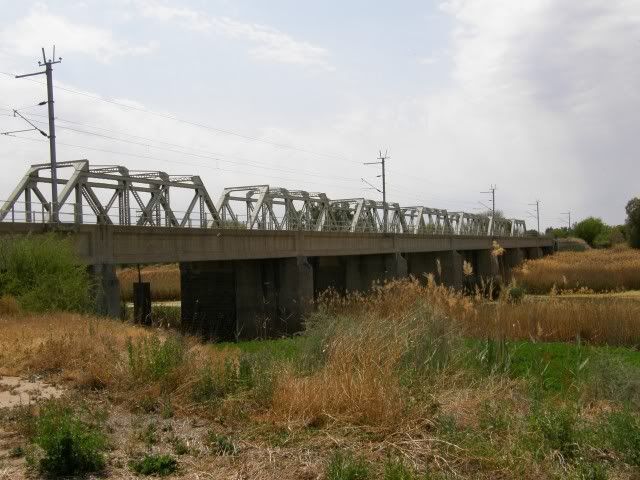
This block house was built later to protect the infrastucture.

This is what the battlefield looks like today. Amazing to think over 500 people died here that day.

And so we continued on the Kimberly for lunch. I saw some family and they informed us that the road between Kimberly and Warrenton had road works and five 20 minute stops.
 That does not sound like fun. Well, we have time and are willing to travel. Lets head in another direction. I've always wanted to see Spitskop dam (more about that later) so we headed West toe Barkley West.
That does not sound like fun. Well, we have time and are willing to travel. Lets head in another direction. I've always wanted to see Spitskop dam (more about that later) so we headed West toe Barkley West.A "quick" stop to greet some more of my family, which ended up being our last stop for the day. As visits with family go it quickly turned into plans for a braai that evening. Great company, great food and so many interesting pets!

I really enjoyed this! They had scorpions, spiders, snakes, lizards, dragons, chameleons - to many to name. They even have 2 crocodiles arriving next week. Their habitat is already built.




These Leopard Gecko's were very interesting.

I wish my sons could see all of this.
A large chameleon from Madagascar:
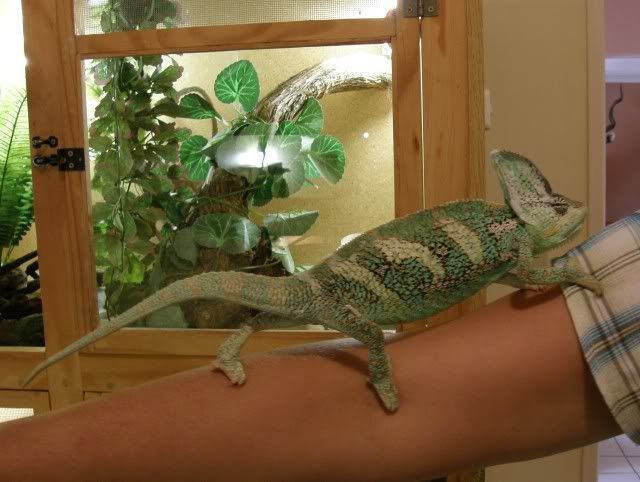

At feeding time we fed the various snakes and I got some great video footage of them striking and eating some mice. I will upload these as soon as I get home.
A great end to a great day.
Day 3
Few photos today. The camera was still set for taking photographs indoors at night with the subject behind glass so most of today's pics were not usable.

Today we hit gravel right from the word go traveling North West towards the Spitskop dam.

In my experience Day 3 is always the best day of a ride. By now you have switched off from your usual daily grind and you have settled into a routine. It was also to nice to be doing more gravel

The Spitkop dam:

Under this dam lies what used to be my dad's farm. The government disowned the land to build the dam and he moved on and bought a farm in George. All of this happened before I was born, but these events probably had huge bearing on my life.
This was my first time here.
Traveling past the dam towards Jan Kempdorp the whole landscape changed. Greenery everywhere!

It is clear that there are lots of water available to these farmers and the literally farm with everything. Crops, fruit (including Citrus), livestock, Olives and we even saw a Wine cellar! The roads are in a good condition (as in the rest of the Northern Cape) with green grass and trees lining it. I thought to myself (more than once) that I might as well have been riding between the farms in George. This is an oasis in the middle of the dry Northern Cape.
Next to the road there was another 1 metre wide tar "road" especially for the bicycles.
 I was truly surprised and impressed with this area.
I was truly surprised and impressed with this area.
We were enjoying the ride and scenery, looking around and generally going slower and sticking to the speed limits.


We were riding along when suddenly...

We were all smiles. I had no idea how fast we were going or what the limit was in the area, but we were just in such a good mood. He checked my license, lights, tyres etc. It was just a routine check and wished us a good journey ahead. What a friendly bloke.
We were now on the N18 traveling North into the North West Province - Taung, Pudimo & Huhudi (Vryburg). Still some interresting things around:
The Taung Skull
The Taung Heritage Site is of enormous scientific importance. It was at these limestone diggings at the old Buxton quarry in 1924 that the lime encrusted skull of a child was unearthed.
The discovery of the Taung child skull at the Buxton quarry was heralded as one of the most significant archaeological events of the time. The find effectively advanced the evidence of the existence of early man in Africa by more than a million years, leading many scientists to believe that the origin of early man was indeed initiated on the African continent.
The Taung Heritage Site is of enormous scientific importance. It was at these limestone diggings at the old Buxton quarry in 1924 that the lime encrusted skull of a child was unearthed.
The discovery of the Taung child skull at the Buxton quarry was heralded as one of the most significant archaeological events of the time. The find effectively advanced the evidence of the existence of early man in Africa by more than a million years, leading many scientists to believe that the origin of early man was indeed initiated on the African continent.
The difference between the two provinces is apparent. The road condition worsened there were free moving animals everywhere. We were cruising the whole morning but now we were going even slower. We were dodging cattle, sheep, goats, donkeys, horses, people, dogs and chickens.


By the time we got to Vryburg we had to fill up. After riding so slowly our fuel consumption was a whopping 20,6 km/L
 Two up with luggage! It pays to go slow
Two up with luggage! It pays to go slow 
Some more interesting sounding little towns like Delareyville, Sannieshof and Biesiesvlei (sorry - no pics) en route to Lichtenburg, our destination for the day.
Another great day's riding. By now we have travelled 1200 problem free km. The TransAlp is just purring along. Day 4 would be a "rest day" in Sun City.
Day 4
Not much to report about on Day 4. We had a rest day in Sun City.
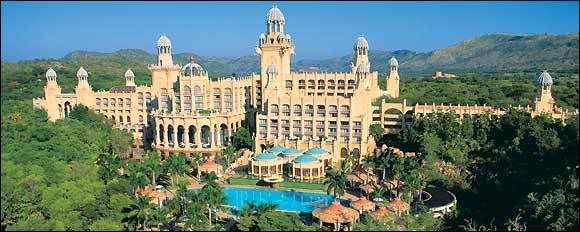
Always nice to treat and pamper the love of your life. We went to see the show as promised - had great tickets, 2nd row!

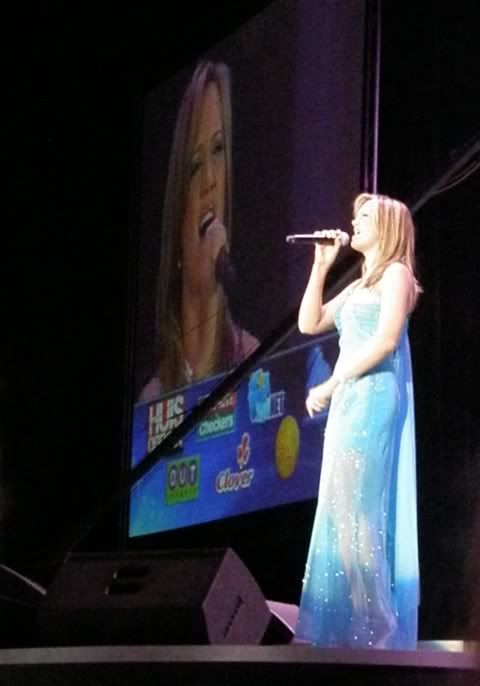


Mrs. TR loved it! Mission accomplished.
Day 5
The next couple of days we spend in Lichtenburg visiting family. As it turns out we’re staying on a farm just outside of Lichtenburg and it’s not just any farm – it’s a Game Farm!
All I can say is wow! I’ve never had the opportunity to see wild animals, especially the predators, up close like this. This was an amazing experience.
Peanut, the tame warthog, up close and personal.

Nile Crocodile:
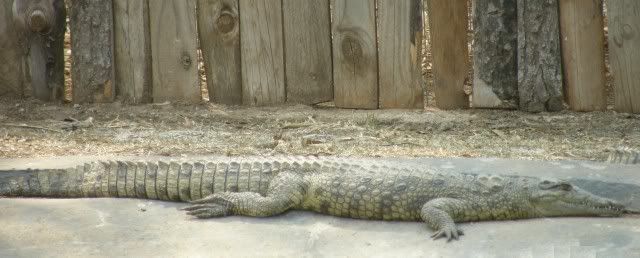
These were still small. I went into the enclosure to see them up close, but when the mom noticed me I hightailed it out of there!

"Bakoor" Jackal

Seems like the Lichtenburg Wild dogs take it easy

But the highlight of course was the cats! Most were wild and kept that way, but some were bought in from farms where they had human contact so these cats would walk up for some attention. What an amazing experience. The first cat we saw was a (wild) Rooikat. He just ate a chicken. They seem quite ferocious.
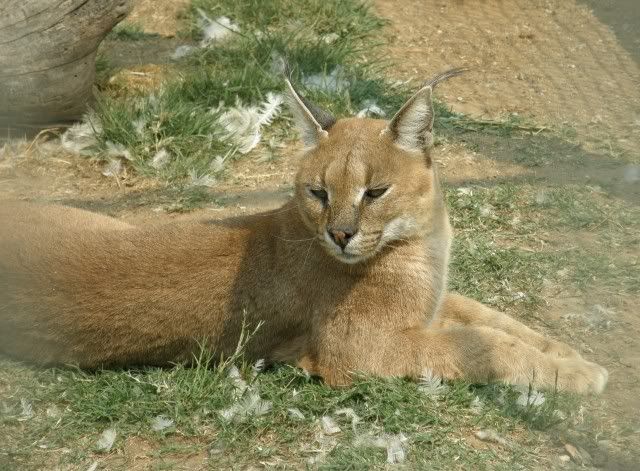
Then we saw a “Tierboskat”, but he was very elusive so I don’t have a pic.
The Leopard is amazing. This really is a beautiful animal.


That was until we saw the Tigers!
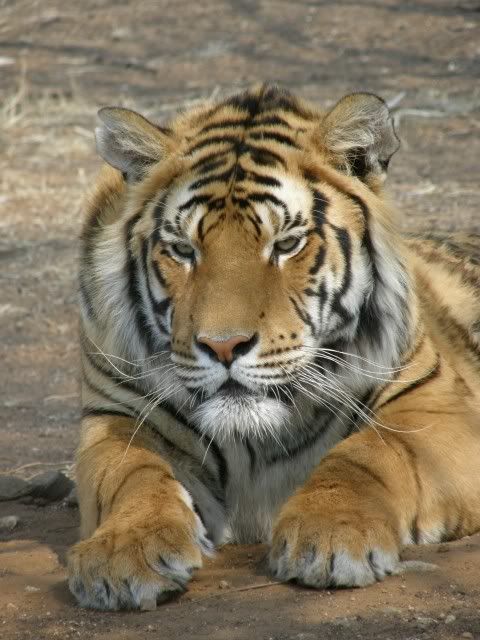
These are BIG. Those paws have to be seen to be believed. This one grew up in some-one’s garden:

But when he got to big they had to get rid of him and so he ended up on the farm. He would walk right up to the fence to be petted!

Then we saw the King of the animals.

I was surprised at how big these cats really are.




And they get still get bigger I’m told. These males were only 20 months old. Most were wild, but three of them came up to be petted.

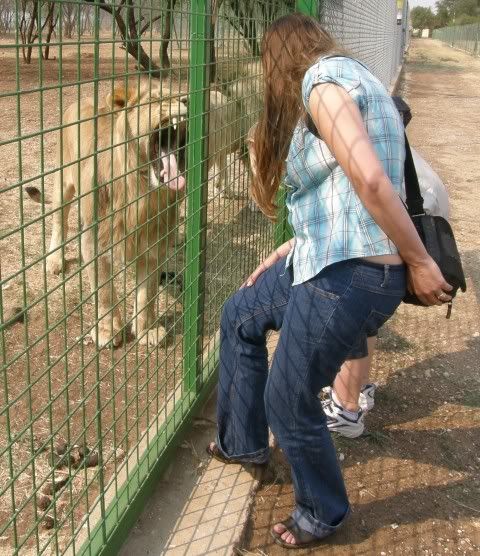
Believe me - when a Lion roars this close to you, you are filled with the fear of God! Especially when it is unexpected.
This was my first experience with Lions. They are awesome awesome animals. While we were walking along the camp the three males would walk next to us along the fence. Amazing.
What a trip we’re having! Walking with a Lion is an experience I will cherish for the rest of my life.
Not much to report about on Day 4. We had a rest day in Sun City.

Always nice to treat and pamper the love of your life. We went to see the show as promised - had great tickets, 2nd row!




Mrs. TR loved it! Mission accomplished.
Day 5
The next couple of days we spend in Lichtenburg visiting family. As it turns out we’re staying on a farm just outside of Lichtenburg and it’s not just any farm – it’s a Game Farm!
All I can say is wow! I’ve never had the opportunity to see wild animals, especially the predators, up close like this. This was an amazing experience.
Peanut, the tame warthog, up close and personal.

Nile Crocodile:

These were still small. I went into the enclosure to see them up close, but when the mom noticed me I hightailed it out of there!


"Bakoor" Jackal

Seems like the Lichtenburg Wild dogs take it easy


But the highlight of course was the cats! Most were wild and kept that way, but some were bought in from farms where they had human contact so these cats would walk up for some attention. What an amazing experience. The first cat we saw was a (wild) Rooikat. He just ate a chicken. They seem quite ferocious.

Then we saw a “Tierboskat”, but he was very elusive so I don’t have a pic.
The Leopard is amazing. This really is a beautiful animal.


That was until we saw the Tigers!

These are BIG. Those paws have to be seen to be believed. This one grew up in some-one’s garden:

But when he got to big they had to get rid of him and so he ended up on the farm. He would walk right up to the fence to be petted!

Then we saw the King of the animals.

I was surprised at how big these cats really are.




And they get still get bigger I’m told. These males were only 20 months old. Most were wild, but three of them came up to be petted.


Believe me - when a Lion roars this close to you, you are filled with the fear of God! Especially when it is unexpected.
This was my first experience with Lions. They are awesome awesome animals. While we were walking along the camp the three males would walk next to us along the fence. Amazing.
What a trip we’re having! Walking with a Lion is an experience I will cherish for the rest of my life.
Day 6
Today I ride with the local Wild Dogs! I just knew this was going to be good.
When I arrived at the designated spot Jo GSA (BMW GSA), Stofstreep (KLR650) and HennieS (V-Strom 650) were already waiting.

We rode out on the Koster road where we took the first dirt.


This area is flat and dry. They certainly need some rain.

Then, suddenly, towards Groot Marico things started to change. More hills, more trees and much more green.


I stopped every so often for a photo. They must have thought this "Capie" is mad But hey, when am I going to have a chance to ride here again.
But hey, when am I going to have a chance to ride here again. 
Little did I know that the best was yet to come. Jo GSA organized some special trails for us

Look at this! I mean, look at this! Who would have thought?

This great spot is where we stopped for lunch. Jo GSA even brought us some biltong and droewors
The TA saw some dirt, that's for sure!

My view during Tuesday lunch. To think that other people were sitting behind their desks now How privileged we are.
How privileged we are.

Next Stofstreep took the lead. I think Jo GSA was feeling bad that the Beemer was the only bike with no dust on
Stofstreep took us all the way to Groot Marico and then along a little gravel railway service road.

These guys know all the best places. Always good to have a "local contact". Next we took some nice high speed gravel towards "Wondergat". I was following Stofstreep through a long sweeping turn that he power-slid through. It looked very cool but at the same time I was hoping my rear stays put
but at the same time I was hoping my rear stays put 
Jo GSA and his "Mothership" bringing up the rear.


Wondergat is a popular cave diving spot. Apparently 23 divers have lost their lives here so far.

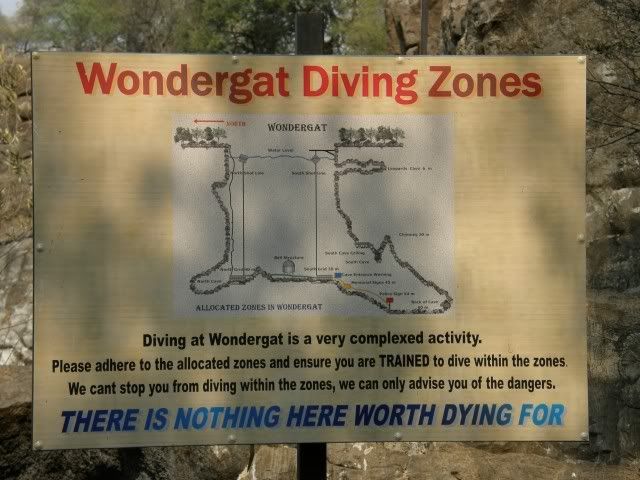

Then HennieS took the lead and took us to the Molopo eye. This is where the Molopo River rises. In the distant past the Molopo flowed into the Orange River and then to the Atlantic Ocean. A dam wall was built across the river on the orders of President Kruger to prevent residents of Mafikeng from receiving water. It was little realised that the river flowed underground through Mafikeng anyway. This was also the only source of water for Bakerville during the Diamond Rush. This is an protected area.

The clear water springs from the earth (you can actually see it) from an underground lake. It's also the habitat of the Dwarf Tilapia, a small fish found only here and in the Okavango Delta.
The water is so clear you can see all the way to the bottom. The fish are easy to spot.

What a great day. This area has so much to offer. It's a pity I didn't have another day to explore.
Thanks so much to Jo GSA, Stofstreep and HennieS for organizing this day and taking time on a week day to show me around. It is much appreciated. If ever you find yourselves in the Southern Cape give me a shout. I'll gladly return the favour.
Day 7
Today we turn South again to travel to a friend's farm in the Western Freestate. On Day 8 we will follow the Battle fields to Bloemfontein where we'll meet our son before the National Karate Championships. I have been noticing that Mrs. TR was becoming homesick, missing the boys especially.
But before we leave there is more to see in Lichtenburg. We could easily have spent another day here and still not see everything Lichtenburg has to offer. We will be back.
First we set off to go and search for General Koos de la Rey's grave. It wasn't hard to find.

General De la Rey
Koos de la Rey was a Boer general during the Boer War and is widely regarded as being one of the strongest military leaders during that conflict.
He is generally regarded as the bravest of the Boer generals during the Second Boer War and as one of the leading figures of Boer independence. As a guerrilla, his tactics proved extremely successful. De la Rey opposed the war until the last, but when he was once accused of cowardice he replied that if the time for war came, he would be fighting long after all those clamoring for war had given up.
This proved to be the case.
At the battle of Modderriver - the battle field we visited on Day 2 - one of Koos de la Rey's sons were killed. His grave is right beside that of his father.

When we were at Modderriver I found it hard to believe that over 500 people died there that day. It was just history, a story. Somehow standing here at this grave made it more real. Fathers, brothers, sons, real people died that day.
Several other graves from that period line the graveyard including graves of the English soldiers that lost their lives. I wonder if their relatives ever saw these graves.

In Lichtenburg, next to the museum, is a statue in honour of Genl. De la Rey.

I desperately wanted to see the museum, but we had to cover 500km today and it was getting late. Like I said - we will be back.
We refueled and Mrs. TR gave the bike a quick wash. It was extremely dusty after the ride with the Lichtenburg Wild Dogs the day before.

We decided on a longer route through the Freestate just because we'd be travelling on mostly minor roads and we have not been there before. As has become the custom on this tour we turned into each and every town to get a "feel" of what the town is like. Once again some towns have character and others seem to be in serious decline. Most old towns have nice churches though.
Ottosdal:
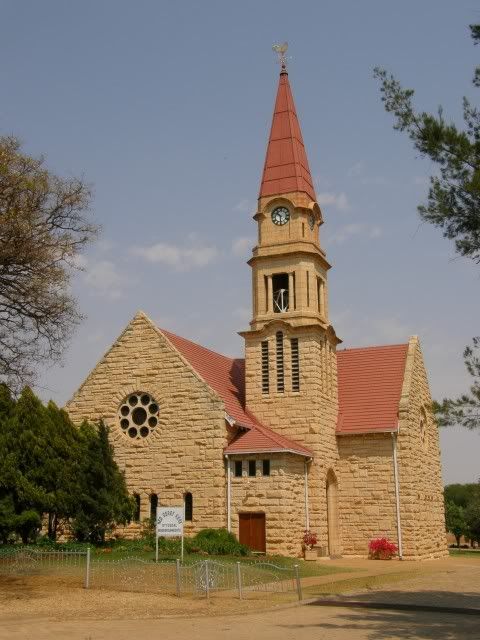
Wolmeranstad:

Makwassie is one of those towns that seems to be on the way down


Over the Orange river and into the fourth Province - the Freestate.

Some game right across the river:

But soon we saw how flat and windy the Freestate can be. That's not cloud cover - it's dust!

Not pleasant riding conditions at all.
We turned West at Wesselsbron and luckily some time after lunch the wind died down somewhat, but the landscape was still as flat as a pancake.

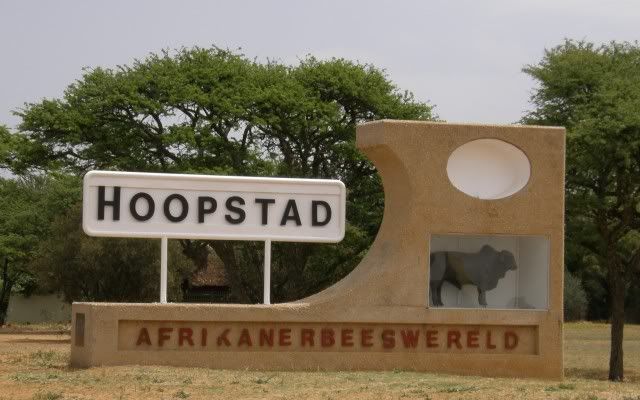
Then on to Hertzogville, Boshof...

...and briefly back into the Northern Cape to visit the Battle Field Monument at Magerfontein.


Battle of Magersfontein
Size of the armies: 8,000 British against 9,000 Boers.
After the action at the Modder River Methuen was forced to delay at the river crossing for several days. This gave the Boers time to reorganise. De la Rey persuaded the Boers not to occupy the prominent Magersfontein Hills, but to dig trenches at the foot of the hills.
The Boers had spotted the approaching British when they were about nine hundred yards away, but held their fire. Finally, when they were only four hundred yards away from the trenches, Wauchope ordered the brigade to deploy. Seconds later, the Boers opened fire.
The dense column was caught while changing formation and was thrown into confusion. The three battalions of the Highland Brigade were unable to advance or retreat, and had to lie on the veld, tormented by ants and thirst. Methuen was unable to send help to them. His artillery pounded the hills and missed the Boer trenches.
The cavalry and Guards Brigade tried to prevent Boers working round the right flank of the highlanders. but in mid-afternoon, the Highland Brigade broke and retreated under heavy fire. As they tried to rally out of effective rifle range, the Boer artillery opened fire for the first time.
British casualties were 902. The Highland Brigade lost 53 officers and 650 soldiers, among them the brigade commander, Major General Wauchope, and 2 commanding officers killed. The commanding officer of the Gordons was also killed. Boer casualties were 236.
The week from December 10 to December 17 where the British also lost battles at Colenso and Stormberg was known in England as "Black Week". The defeat caused much consternation in Britain, particularly in Scotland where the losses to the Highland regiments were keenly felt.
De La Rey's brilliant tactics were ground breaking. His use of trenches, barbed wire and guerrilla tactics is still used years later. Some of the English became entangled in a wire farm fence in front of the trenches and were shot there, in a grim foretaste of the Western Front in World War I. De la Ray did not participate in the Battle of Magersfontein - he was attending the funeral of his son.
This monument was erected in honour of the Boers that died in the battle at Magersfontein and other battles in the area.

The Boers' leaders lead from the front and amongst the casualties were some of the General's staff. They have a special wall of remembrance at the site.

The name of the son of General De La Rey is listed here as well as that of Brigadier JC van Tonder. For those have not guessed it by now, my family (as well as my spouse's family) were directly involved in the war on the Boer's side. Van Tonder is my family name.

All the names of casualties of the battles in the area are listed here. Most Afrikaans surnames are represented. This is one example:

The Boers' were known to bury the English casualties if the English could not. There were also occasions where the Boers sent English prisoners of war back to the English camps because they would receive better medical care.

This is a remarkable site - well worth the visit.
It was getting late. We had to get to our friends' farm. Luckily it wasn't to far off. Back into the Western Freestate. the farm is just across the border.



We had covered more than 500km today. The windy conditions weren't great, but the TransAlp never missed a beat and we were thankfull for the very comfortable seat. This was Day 7 and not once we were uncomfortable on the bike.
Tomorrow we head East - destination Bloemfontein.
Today I ride with the local Wild Dogs! I just knew this was going to be good.
When I arrived at the designated spot Jo GSA (BMW GSA), Stofstreep (KLR650) and HennieS (V-Strom 650) were already waiting.

We rode out on the Koster road where we took the first dirt.


This area is flat and dry. They certainly need some rain.

Then, suddenly, towards Groot Marico things started to change. More hills, more trees and much more green.


I stopped every so often for a photo. They must have thought this "Capie" is mad
 But hey, when am I going to have a chance to ride here again.
But hey, when am I going to have a chance to ride here again. 
Little did I know that the best was yet to come. Jo GSA organized some special trails for us


Look at this! I mean, look at this! Who would have thought?

This great spot is where we stopped for lunch. Jo GSA even brought us some biltong and droewors

The TA saw some dirt, that's for sure!

My view during Tuesday lunch. To think that other people were sitting behind their desks now

Next Stofstreep took the lead. I think Jo GSA was feeling bad that the Beemer was the only bike with no dust on

Stofstreep took us all the way to Groot Marico and then along a little gravel railway service road.

These guys know all the best places. Always good to have a "local contact". Next we took some nice high speed gravel towards "Wondergat". I was following Stofstreep through a long sweeping turn that he power-slid through. It looked very cool
Jo GSA and his "Mothership" bringing up the rear.


Wondergat is a popular cave diving spot. Apparently 23 divers have lost their lives here so far.



Then HennieS took the lead and took us to the Molopo eye. This is where the Molopo River rises. In the distant past the Molopo flowed into the Orange River and then to the Atlantic Ocean. A dam wall was built across the river on the orders of President Kruger to prevent residents of Mafikeng from receiving water. It was little realised that the river flowed underground through Mafikeng anyway. This was also the only source of water for Bakerville during the Diamond Rush. This is an protected area.

The clear water springs from the earth (you can actually see it) from an underground lake. It's also the habitat of the Dwarf Tilapia, a small fish found only here and in the Okavango Delta.
The water is so clear you can see all the way to the bottom. The fish are easy to spot.

What a great day. This area has so much to offer. It's a pity I didn't have another day to explore.
Thanks so much to Jo GSA, Stofstreep and HennieS for organizing this day and taking time on a week day to show me around. It is much appreciated. If ever you find yourselves in the Southern Cape give me a shout. I'll gladly return the favour.
Day 7
Today we turn South again to travel to a friend's farm in the Western Freestate. On Day 8 we will follow the Battle fields to Bloemfontein where we'll meet our son before the National Karate Championships. I have been noticing that Mrs. TR was becoming homesick, missing the boys especially.
But before we leave there is more to see in Lichtenburg. We could easily have spent another day here and still not see everything Lichtenburg has to offer. We will be back.
First we set off to go and search for General Koos de la Rey's grave. It wasn't hard to find.

General De la Rey
Koos de la Rey was a Boer general during the Boer War and is widely regarded as being one of the strongest military leaders during that conflict.
He is generally regarded as the bravest of the Boer generals during the Second Boer War and as one of the leading figures of Boer independence. As a guerrilla, his tactics proved extremely successful. De la Rey opposed the war until the last, but when he was once accused of cowardice he replied that if the time for war came, he would be fighting long after all those clamoring for war had given up.
This proved to be the case.
At the battle of Modderriver - the battle field we visited on Day 2 - one of Koos de la Rey's sons were killed. His grave is right beside that of his father.

When we were at Modderriver I found it hard to believe that over 500 people died there that day. It was just history, a story. Somehow standing here at this grave made it more real. Fathers, brothers, sons, real people died that day.
Several other graves from that period line the graveyard including graves of the English soldiers that lost their lives. I wonder if their relatives ever saw these graves.

In Lichtenburg, next to the museum, is a statue in honour of Genl. De la Rey.

I desperately wanted to see the museum, but we had to cover 500km today and it was getting late. Like I said - we will be back.
We refueled and Mrs. TR gave the bike a quick wash. It was extremely dusty after the ride with the Lichtenburg Wild Dogs the day before.


We decided on a longer route through the Freestate just because we'd be travelling on mostly minor roads and we have not been there before. As has become the custom on this tour we turned into each and every town to get a "feel" of what the town is like. Once again some towns have character and others seem to be in serious decline. Most old towns have nice churches though.
Ottosdal:

Wolmeranstad:

Makwassie is one of those towns that seems to be on the way down



Over the Orange river and into the fourth Province - the Freestate.

Some game right across the river:

But soon we saw how flat and windy the Freestate can be. That's not cloud cover - it's dust!

Not pleasant riding conditions at all.

We turned West at Wesselsbron and luckily some time after lunch the wind died down somewhat, but the landscape was still as flat as a pancake.


Then on to Hertzogville, Boshof...

...and briefly back into the Northern Cape to visit the Battle Field Monument at Magerfontein.


Battle of Magersfontein
Size of the armies: 8,000 British against 9,000 Boers.
After the action at the Modder River Methuen was forced to delay at the river crossing for several days. This gave the Boers time to reorganise. De la Rey persuaded the Boers not to occupy the prominent Magersfontein Hills, but to dig trenches at the foot of the hills.
The Boers had spotted the approaching British when they were about nine hundred yards away, but held their fire. Finally, when they were only four hundred yards away from the trenches, Wauchope ordered the brigade to deploy. Seconds later, the Boers opened fire.
The dense column was caught while changing formation and was thrown into confusion. The three battalions of the Highland Brigade were unable to advance or retreat, and had to lie on the veld, tormented by ants and thirst. Methuen was unable to send help to them. His artillery pounded the hills and missed the Boer trenches.
The cavalry and Guards Brigade tried to prevent Boers working round the right flank of the highlanders. but in mid-afternoon, the Highland Brigade broke and retreated under heavy fire. As they tried to rally out of effective rifle range, the Boer artillery opened fire for the first time.
British casualties were 902. The Highland Brigade lost 53 officers and 650 soldiers, among them the brigade commander, Major General Wauchope, and 2 commanding officers killed. The commanding officer of the Gordons was also killed. Boer casualties were 236.
The week from December 10 to December 17 where the British also lost battles at Colenso and Stormberg was known in England as "Black Week". The defeat caused much consternation in Britain, particularly in Scotland where the losses to the Highland regiments were keenly felt.
De La Rey's brilliant tactics were ground breaking. His use of trenches, barbed wire and guerrilla tactics is still used years later. Some of the English became entangled in a wire farm fence in front of the trenches and were shot there, in a grim foretaste of the Western Front in World War I. De la Ray did not participate in the Battle of Magersfontein - he was attending the funeral of his son.
This monument was erected in honour of the Boers that died in the battle at Magersfontein and other battles in the area.

The Boers' leaders lead from the front and amongst the casualties were some of the General's staff. They have a special wall of remembrance at the site.

The name of the son of General De La Rey is listed here as well as that of Brigadier JC van Tonder. For those have not guessed it by now, my family (as well as my spouse's family) were directly involved in the war on the Boer's side. Van Tonder is my family name.

All the names of casualties of the battles in the area are listed here. Most Afrikaans surnames are represented. This is one example:

The Boers' were known to bury the English casualties if the English could not. There were also occasions where the Boers sent English prisoners of war back to the English camps because they would receive better medical care.

This is a remarkable site - well worth the visit.
It was getting late. We had to get to our friends' farm. Luckily it wasn't to far off. Back into the Western Freestate. the farm is just across the border.



We had covered more than 500km today. The windy conditions weren't great, but the TransAlp never missed a beat and we were thankfull for the very comfortable seat. This was Day 7 and not once we were uncomfortable on the bike.
Tomorrow we head East - destination Bloemfontein.
Day 8
We were up early this morning. Mrs. TR was all excited about seeing our eldest again - if it was up to her we'd head straight for Bloemfontein on the N8, but I had a gravel route in mind.
Early morning on a Freestate farm:




Our first stop was at the museum of the Battle of Paardeberg.

Battle of Paardeberg
Size of the armies: 15,000 British troops against 7,000 Boers.
On 15 February, Cronje's men finally evacuated their laager at Jacobsdal (close to Magersfontein). Their position was redundant and they were in danger of being outflanked. On the 17th, the large convoy of Boer wagons reached the crossing of the Modder river at Paardeberg Drift. They were starting to cross the river when a force of British mounted troops opened fire on them unexpectedly from the north, causing confusion.
Cronje then inadvisedly decided to form a laager and dig in on the banks of the Modder river. His reason for doing so are unclear. The British now outnumbered his force significantly and enjoyed overwhelming superiority in artillery. Lieutenant General Thomas Kelly-Kenny of the British 6th Division had a sound plan to lay siege to Cronje and bombard his force into surrender. This would almost certainly have proved successful and cost the British very few casualties.
However, Kitchener was now in overall command of the British force. He had different plans, and overruled Kelly-Kenny. He decided that Cronjé's position must be taken by storm immediately. This was despite the fact that the cost of frontal assaults against entrenched Boers had been demonstrated time and again the preceding months. It was no different this time. The British were shot down in their droves. It is thought that not a single British soldier got within 200 yards of the Boer lines. By nightfall some 24 officers and 279 men were killed and 59 officers and 847 men wounded. Judged by British casualties it was the most severe reverse of the war and became known as Bloody Sunday.
But seen from the Boer side, things were also bad. Cronjé and his men had been in headlong retreat for several days with the British snapping at their heels. While casualties from the bombardment had been reduced to around 100 dead and 250 wounded by the soft bank of the Modder, the horses, oxen and wagons had no trenches in which to shelter. Many wagons were destroyed. Ammunition exploded and stores were ruined. For many of the Burghers, these wagons carried the sum total of their worldly possessions. The loss of their horses was even worse, for the horse was almost as important to the fighting ability of a Boer as his Mauser. The morale in Cronjé's laager was desperate.
The sun came up and General Roberts now arrived on the scene. He initially urged a resumption of the frontal assaults but Cronje requested a cease-fire to bury the dead. The British refused (to their shame, as the Boers has allowed such truces in the past) and Cronje replied "Bombard as you will".
On February 27, 1900, the Boers surrendered. Cronje surrendered with some 4,019 men and 50 women. It was the first Brittish (and some would argue only) great victory of the war.
Entry to the Museum is R2 The museum is very informative with scale models of the battle, as well as some artistic impressions and relics collected from the site.
The museum is very informative with scale models of the battle, as well as some artistic impressions and relics collected from the site.

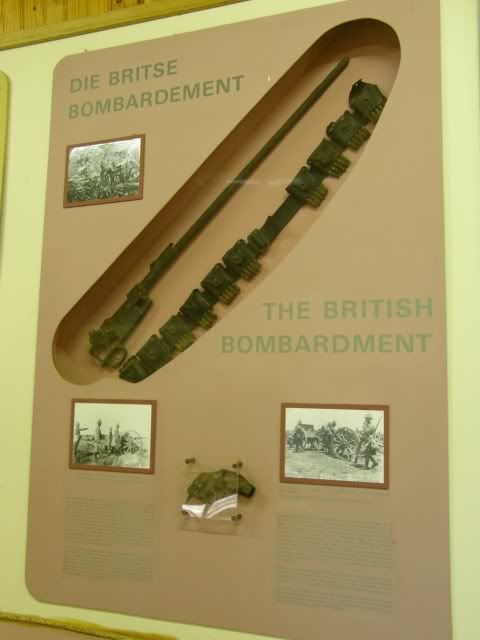

The monument at the site, again with a list of names of the fallen soldiers.

The site today:
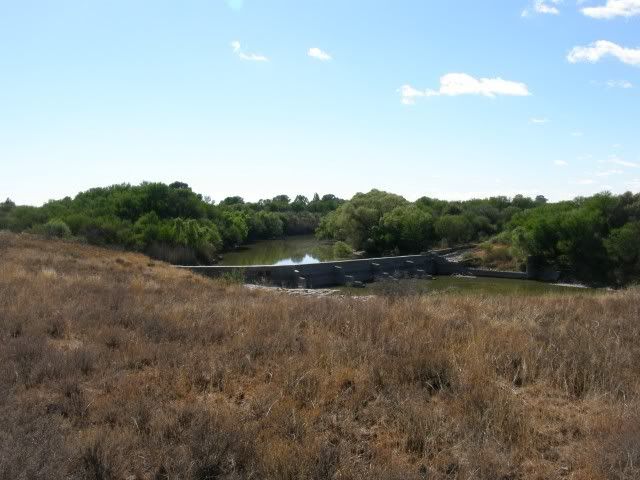
Battle of Poplar Grove
The battle of Poplar Grove saw the failure of both a Boer attempt to defend Bloemfontein and a British attempt to capture the main Boer army in the Orange Free State.
The Boers at Poplar Grove were badly outnumbered. In the aftermath of the surrender at Paardeberg, only around 6,000 men were left to defend the Orange Free State capital. They had a new commander, Christiaan De Wet. His main problem was that the morale of the Boer commandoes was at a very low ebb after Cronjé’s surrender.
The British commander, Lord Roberts, decided to send two infantry division straight at the Boer position, while the cavalry made a wide flanking move to the south. That advance never needed to turn into an attack. The British infantry came into view from the Boer camp at about 8 a.m. Demoralized by recent events, they retreated. When De Wet made his next stand at Driefontein it was with only 1,500 men.

Battle of Driefontein
The battle of Driefontein was the last attempt to prevent the British from occupying Bloemfontein, the capital of the Orange Free State. Under the command of Christiaan De Wet, with assistance from De La Rey, the Boers organised a new defensive line at Driefontein.
This time they fought, and fought well. Lord Roberts organised his men into three columns and attacked along the entire Boer line. Despite being heavily outnumbered, the Boers managed to hold on all day, but as darkness fell the British had seized the northern end of the Boer line, and were threatening the southern flanks. Three days later the British captured Bloemfontein without facing any more significant resistance.
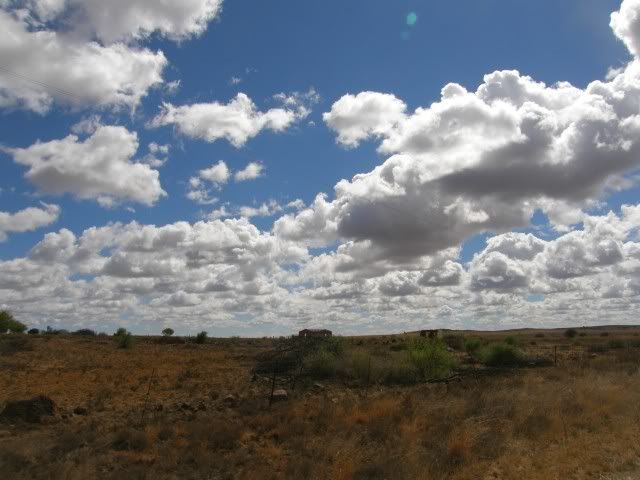
Even though Bloemfontein fell, the war continued and the British faced fierce opposition from the Transvaal Boers.
Lord Kitchener, the new British commander, adopted tactics to "clean up" a war that many in Britain had considered already won. In waging ruthless war against an entire people, he ordered his troops to destroy livestock and crops, burn down farms, and herd women and children into "camps of refuge." Reports about these grim internment centers, which were soon called concentration camps, shocked the western world.
Britain's new style of waging war was summarized in a report made in January 1902 by Jan Smuts, the 31-year-old Boer general (and future South African prime minister):
While in Bloemfontein we would visit the Woman's Monument devoted to the women and girls who died in the English concentration camps, but first we see our son and support him at the National Karate Championships.
Our home for the next three days - the Trailrider Hilton Hotel

We were up early this morning. Mrs. TR was all excited about seeing our eldest again - if it was up to her we'd head straight for Bloemfontein on the N8, but I had a gravel route in mind.

Early morning on a Freestate farm:




Our first stop was at the museum of the Battle of Paardeberg.

Battle of Paardeberg
Size of the armies: 15,000 British troops against 7,000 Boers.
On 15 February, Cronje's men finally evacuated their laager at Jacobsdal (close to Magersfontein). Their position was redundant and they were in danger of being outflanked. On the 17th, the large convoy of Boer wagons reached the crossing of the Modder river at Paardeberg Drift. They were starting to cross the river when a force of British mounted troops opened fire on them unexpectedly from the north, causing confusion.
Cronje then inadvisedly decided to form a laager and dig in on the banks of the Modder river. His reason for doing so are unclear. The British now outnumbered his force significantly and enjoyed overwhelming superiority in artillery. Lieutenant General Thomas Kelly-Kenny of the British 6th Division had a sound plan to lay siege to Cronje and bombard his force into surrender. This would almost certainly have proved successful and cost the British very few casualties.
However, Kitchener was now in overall command of the British force. He had different plans, and overruled Kelly-Kenny. He decided that Cronjé's position must be taken by storm immediately. This was despite the fact that the cost of frontal assaults against entrenched Boers had been demonstrated time and again the preceding months. It was no different this time. The British were shot down in their droves. It is thought that not a single British soldier got within 200 yards of the Boer lines. By nightfall some 24 officers and 279 men were killed and 59 officers and 847 men wounded. Judged by British casualties it was the most severe reverse of the war and became known as Bloody Sunday.
But seen from the Boer side, things were also bad. Cronjé and his men had been in headlong retreat for several days with the British snapping at their heels. While casualties from the bombardment had been reduced to around 100 dead and 250 wounded by the soft bank of the Modder, the horses, oxen and wagons had no trenches in which to shelter. Many wagons were destroyed. Ammunition exploded and stores were ruined. For many of the Burghers, these wagons carried the sum total of their worldly possessions. The loss of their horses was even worse, for the horse was almost as important to the fighting ability of a Boer as his Mauser. The morale in Cronjé's laager was desperate.
The sun came up and General Roberts now arrived on the scene. He initially urged a resumption of the frontal assaults but Cronje requested a cease-fire to bury the dead. The British refused (to their shame, as the Boers has allowed such truces in the past) and Cronje replied "Bombard as you will".
On February 27, 1900, the Boers surrendered. Cronje surrendered with some 4,019 men and 50 women. It was the first Brittish (and some would argue only) great victory of the war.
Entry to the Museum is R2



The monument at the site, again with a list of names of the fallen soldiers.

The site today:

Battle of Poplar Grove
The battle of Poplar Grove saw the failure of both a Boer attempt to defend Bloemfontein and a British attempt to capture the main Boer army in the Orange Free State.
The Boers at Poplar Grove were badly outnumbered. In the aftermath of the surrender at Paardeberg, only around 6,000 men were left to defend the Orange Free State capital. They had a new commander, Christiaan De Wet. His main problem was that the morale of the Boer commandoes was at a very low ebb after Cronjé’s surrender.
The British commander, Lord Roberts, decided to send two infantry division straight at the Boer position, while the cavalry made a wide flanking move to the south. That advance never needed to turn into an attack. The British infantry came into view from the Boer camp at about 8 a.m. Demoralized by recent events, they retreated. When De Wet made his next stand at Driefontein it was with only 1,500 men.

Battle of Driefontein
The battle of Driefontein was the last attempt to prevent the British from occupying Bloemfontein, the capital of the Orange Free State. Under the command of Christiaan De Wet, with assistance from De La Rey, the Boers organised a new defensive line at Driefontein.
This time they fought, and fought well. Lord Roberts organised his men into three columns and attacked along the entire Boer line. Despite being heavily outnumbered, the Boers managed to hold on all day, but as darkness fell the British had seized the northern end of the Boer line, and were threatening the southern flanks. Three days later the British captured Bloemfontein without facing any more significant resistance.

Even though Bloemfontein fell, the war continued and the British faced fierce opposition from the Transvaal Boers.
Lord Kitchener, the new British commander, adopted tactics to "clean up" a war that many in Britain had considered already won. In waging ruthless war against an entire people, he ordered his troops to destroy livestock and crops, burn down farms, and herd women and children into "camps of refuge." Reports about these grim internment centers, which were soon called concentration camps, shocked the western world.
Britain's new style of waging war was summarized in a report made in January 1902 by Jan Smuts, the 31-year-old Boer general (and future South African prime minister):
Lord Kitchener has begun to carry out a policy in both [Boer] republics of unbelievable barbarism and gruesomeness which violates the most elementary principles of the international rules of war. Almost all farmsteads and villages in both republics have been burned down and destroyed. All crops have been destroyed. All livestock which has fallen into the hands of the enemy has been killed or slaughtered.
The basic principle behind Lord Kitchener's tactics has been to win, not so much through direct operations against fighting commandos, but rather indirectly by bringing the pressure of war against defenseless women and children.
... This violation of every international law is really very characteristic of the nation which always plays the role of chosen judge over the customs and behavior of all other nations.
The basic principle behind Lord Kitchener's tactics has been to win, not so much through direct operations against fighting commandos, but rather indirectly by bringing the pressure of war against defenseless women and children.
... This violation of every international law is really very characteristic of the nation which always plays the role of chosen judge over the customs and behavior of all other nations.
While in Bloemfontein we would visit the Woman's Monument devoted to the women and girls who died in the English concentration camps, but first we see our son and support him at the National Karate Championships.
Our home for the next three days - the Trailrider Hilton Hotel

Day 9
And so the day arrived. My son has been working towards this goal for an entire year - the South African Karate Championships.
Since I would be spending most of the day at the championships I decided to take a chance and see if the Honda dealer in Bloemfontein could give my TransAlp it's 6000km service today. I walked into the dealership on a Friday morning, without prior notice, and not only asked for a same day service, but also another bike for the day. Even though they didn't know me at all and were clearly very busy they happily obliged. Now that is what I call service!
My wheels for the day (sorry for the crappy cell phone pic):

Somehow I felt like I shouldgofishing

The Championships were very well organized (unlike some of the events we've been to).

Each of the kids standing here are champions in their respective provinces. These kids are the best SA has to offer. (Yeah yeah, I'm a proud parent)


The pressure on these kids is immense. I never faced anything like this when I was ten years old. Andre was doing well, but here all the kids are just as good or better than him. This is not the type of competition where you simply show up to win.
He's fast


The fighting was fierce but the kids showed excellent sportsmanship (also unlike some of the events we've been to). In some cases when an opponent got knocked down the other would even rush over and help him up.

In one of the competitions leading up to this event Andre got kicked in the ribs repeatedly. He carried this lingering injury and as luck would have it he got hit on the exact same spot in one of the fights. I could see him flinch. The medics came over with some ice and the fight continued. Andre was leading on points when he got hit again. This time he went down.
The team manager withdrew him from the tournament. He was devastated. Later examinations showed that he had cracked two ribs. Karate is a tough sport...
This event changed all our trip plans. Mrs. TR decided there and then that she would travel with Andre on the team bus back to George. For the remainder of the trip I'd be riding solo.
Day 10
The TransAlp felt great after the service. Apparently half of Lichtenburg's sand came out of the air filter.

Andre was out of the tournament so there was no reason to stick around in Bloem anymore. Pity I missed out on meeting the Bloem Wild Dogs though.
 I was looking at the maps. The world is my oyster!
I was looking at the maps. The world is my oyster!  A ride around Lesotho maybe?
A ride around Lesotho maybe?  I really wanted to do this trip but decided against it. If I'm going to ride through Natal I want to do it properly, not rush through.
I really wanted to do this trip but decided against it. If I'm going to ride through Natal I want to do it properly, not rush through. South was the only option left. But first - the Womans' Monument.

The National Women's Memorial, a sandstone shrine impressive in its simplicity, is a celebrated example of South African sculpture art created by Anton von Wouw.

The discovery of gold at Witwatersrand in the Transvaal in 1886 ended Boer seclusion, and brought a mortal threat to the young nation's dream of freedom from alien rule. As often happens in history, important aspects of the Anglo-Boer conflict came to light only years after the fighting had ended. In a masterful 1979 study, The Boer War, British historian Thomas Pakenham revealed previously unknown details about the conspiracy of British colonial officials and Jewish financiers to plunge South Africa into war.

Boer men were citizen-soldiers. By law, all males in the two republics between the ages of 16 and 60 were eligible for war service. Even as they prepared to face the might of the world's foremost imperial power, the Boers were confident and determined. Although outnumbered, their morale was good. They were fighting for their land, their freedom and their way of life - and on familiar home territory. Boers fighters were also chivalrous in combat. A few years after the end of the war, when passions had cooled somewhat, the London Times' history of the war conceded:
In the moment of their triumph the Boers behaved with the same unaffected kindheartedness ... which they displayed after most of their victories. Although exultant they were not insulting. They fetched water and blankets for the wounded and treated prisoners with every consideration.
In stark contrast to this Lord Kitchener ordered all Boer prisoners to be killed. In addition to this civilians were to be targeted, their possessions burnt and the women and girls rounded up in camps.John Dillon, an Irish nationalist Member of Parliament, spoke out against the British policy of shooting Boer prisoners of war. On February 26, 1901, he made public a letter by a British officer in the field:
The orders in this district from Lord Kitchener are to burn and destroy all provisions, forage, etc., and seize cattle, horses, and stock of all sorts wherever found, and to leave no food in the houses of the inhabitants. And the word has been passed round privately that no prisoners are to be taken. That is, all the men found fighting are to be shot. This order was given to me personally by a general, one of the highest in rank in South Africa. So there is no mistake about it. The instructions given to the columns closing round De Wet north of the Orange River are that all men are to be shot so that no tales may be told. Also, the troops are told to loot freely from every house, whether the men belonging to the house are fighting or not.
"Lord Kitchener has issued orders that no man has to bring in any Boer prisoners. We take no prisoners now ... There happened to be a few wounded Boers left. We put them through the mill. Every one was killed."
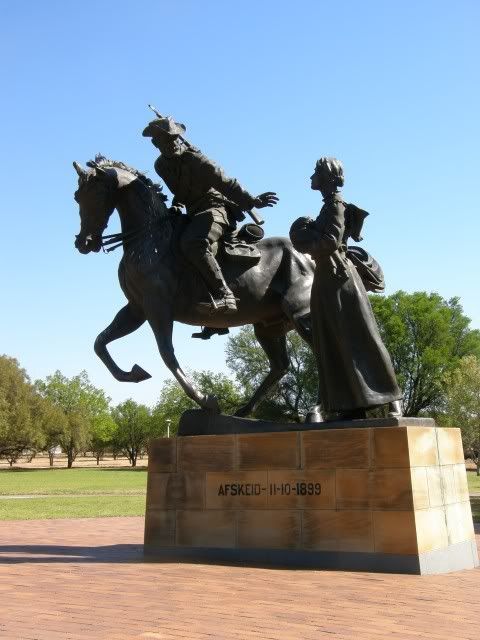
Altogether the British held 116,572 Boers in their South African internment camps -- that is, about a fourth of the entire Boer population -- nearly all of them women and girls.
The boys and old men were sent off to prison camps in India, Bermuda and St. Helena amongst others. Thousands of them died en route and even more died in the prison camps.
There are several plaques with the names of the deceased.


The women and girls held by the British soldiers had it even worse.
A crusading 41-year-old English spinster, Emily Hobhouse, visited the South Africa camps and, armed with this first-hand knowledge, alerted the world to their horrors. She told of internees "... deprived of clothes ... the semi-starvation in the camps ... the fever-stricken children lying... upon the bare earth ... the appalling mortality. These people will never ever forget what has happened," She also declared. "The children have been the hardest hit. They wither in the terrible heat and as a result of insufficient and improper nourishment ... To maintain this kind of camp means nothing less than murdering children."
"These people will never ever forget what has happened" - I will come back to this interesting statement.
Each concentration camp has it's own plaque:

117 Women and 968 girls of fifteen years or younger died in this particular camp.

These individual plaques line the pathway to the monument - both sides...



In a report to members of Parliament, Hobhouse described conditions in one camp she had visited:
... A six month old baby [is] gasping its life out on its mother's knee. Next [tent]: a child recovering from measles sent back from hospital before it could walk, stretched on the ground white and wan. Next a girl of 21 lay dying on a stretcher. The father ... kneeling beside her, while his wife was watching a child of six also dying and one of about five drooping. Already this couple had lost three children.

Hobhouse found that none of their hardships would shake the Boer women's determination, not even seeing their own hungry children die before their eyes. They "never express," she wrote, "a wish that their men must give way. It must be fought out now, they think, to the bitter end."

From Wikipedia:
Concentration Camps
The term concentration camp was first used by the British military during the Boer War (1899-1902). Facing attack by Boer guerrillas, British forces rounded up the Boer women and children as well as black people living on Boer land, and sent them to 34 tented camps scattered around South Africa. This was done as part of a scorched earth policy to deny the boer guerrillas access to the supplies of food and clothing they needed to continue the war.
Though they were not extermination camps, the women and children of Boer men who were still fighting were given smaller rations than others. The poor diet and inadequate hygiene led to endemic contagious diseases such as measles, typhoid and dysentery. Coupled with a shortage of medical facilities, this led to large numbers of deaths — a report after the war concluded that 27,927 Boer (of whom 22,074 were children under 16) and 14,154 black Africans had died of starvation, disease and exposure in the camps. In all, about 25% of the Boer inmates and 12% of the black African ones died.
In contrast to these figures, only around 3,000 Boer men were killed (in combat) during the Boer War.
A delegate of the South African Women and Children's Distress Fund, Emily Hobhouse, did much to publicise the distress of the inmates on her return to Britain after visiting some of the camps in the Orange Free State. Her fifteen-page report caused uproar, and led to a government commission, the Fawcett Commission, visiting camps from August to December 1901 which confirmed her report.
After meeting with Hobhouse, Sir Henry Campbell-Bannerman, leader of the Liberal Party opposition (and future Prime Minister), publicly declared: "When is a war not a war? When it is waged by methods of barbarism in South Africa." This memorable phrase -- "methods of barbarism" -- quickly became widely quoted, provoking both warm praise and angry condemnation.
On the Boer side 90% of the people that died were non-combatants - women, children and the elderly. The British officers and soldiers received lordships, titles and medals for honour and bravery.


After the war ended several books were written (most in Dutch) detailing the battles as well as the war crimes of the British, including accounts of the rapes and gang rapes that was an almost daily occurrence in the concentration camps. These books were banned by the British. The Union of South Africa came into being on 31 May 1910, with the previously separate colonies of the Cape, Natal, Transvaal and the Orange Free State becoming Provinces in the Union of South Africa.
It was founded as a dominion, later Commonwealth realm, but became a republic on 31 May 1961. Even after independence from Brittan these books were not unbanned. It was thought that they would fuel and entrench the hatred against the British and hamper national unity. Few of these records still exist today. The ban is still in place as far as I know.
Today, more than a century later, the atrocities are still not forgotten. Emily Hobhouse was right.
Sources: http://www.wikipedia.org/ . For more info on the Boer War also see Great Boer War and The Boer War Remembered
Time to hit the road.
I stopped for fuel and saw these two classics:
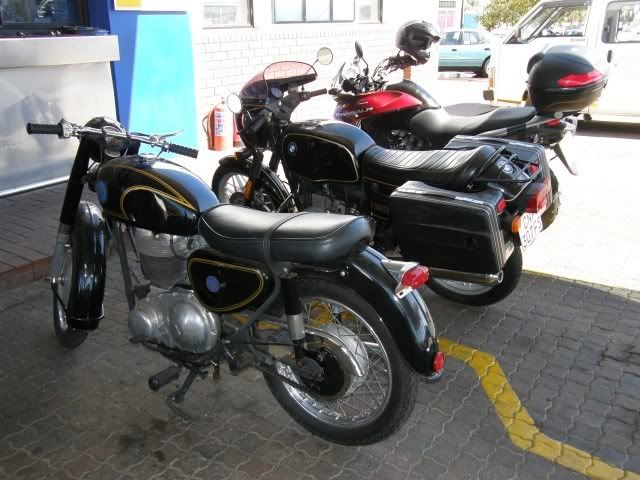
Come to think of it, it almost looks like an evolution photo

I headed South for the hills of the Eastern Cape. I needed some variety in scenery.

The Southern Freestate also has some hills...

...but I'd hate to meet the mole that made this one!

I rode South through Reddersburg but when I got to Smithfield I had a look at the map again. The Gariep Dam to the West seems interesting... And there is a road that runs all along the dam. So off I went. Next town Bethulie.
It lies next to the back end of the Dam, just inside the Freestate border.

The bridge going over into the Eastern Cape carries normal traffic as well as trains.


Well well, the road I saw on the map turns out to be a route


I like solo trips and love the Karoo, but somehow this just didn't feel right.

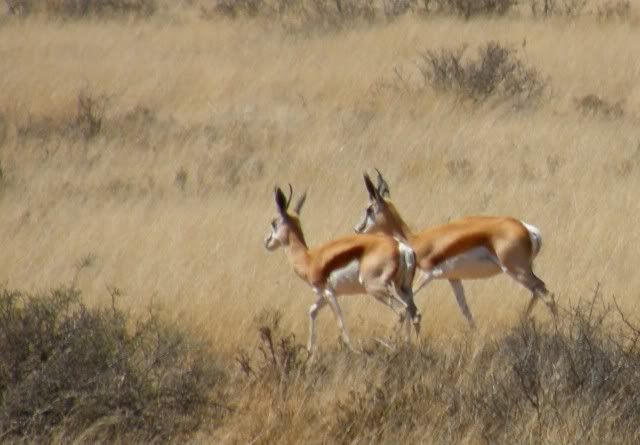
I rode past Venterstad and Steynsburg (I only realized later how close I was to the Stormberg Battlefield
 ) with plans to reach Nieu-Betesda or Graaf Reinet for the night.
) with plans to reach Nieu-Betesda or Graaf Reinet for the night.
It was just after midday (and the heat was unbearable) when I rode into Middelburg. I refeuled and then I saw this!

BMW's (650, 800, 1200) as well as a V-strom 650 and a DRZ400. These just had to be Eastern Cape Wild Dogs
 Just a bunch of friends on an out-ride and on their way back to PE just as I sat down. Nice blokes though.
Just a bunch of friends on an out-ride and on their way back to PE just as I sat down. Nice blokes though.After lunch and another beer the rugby started. When I ordered my third beer I knew I was staying. I booked into the Karoo Country Inn for the night.
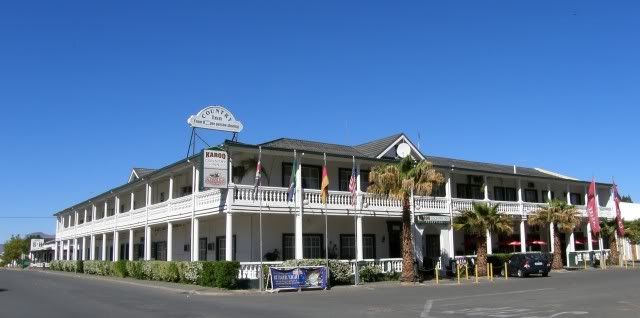
It was nice mingling with the locals and getting a feeling for the town. The one guy I watched the rugby with turned out to be an estate agent from Noupoort. Of course he had an investment opportunity I just "couldn't afford to miss"
 Don't you just hate pushy salesmen? The second game I watched in the safety of my air conditioned hotel room while I worked on the ride report.
Don't you just hate pushy salesmen? The second game I watched in the safety of my air conditioned hotel room while I worked on the ride report.I did just over 400km for the day.
Day 11
When I woke up this morning I knew the trip was over. I'm going home. I had to ride just over 480km and I phoned Mrs. TR and told her that I'd be home for lunch. The decision was made. It was time.
I was in high spirits as I rode through the Mid-Karoo.
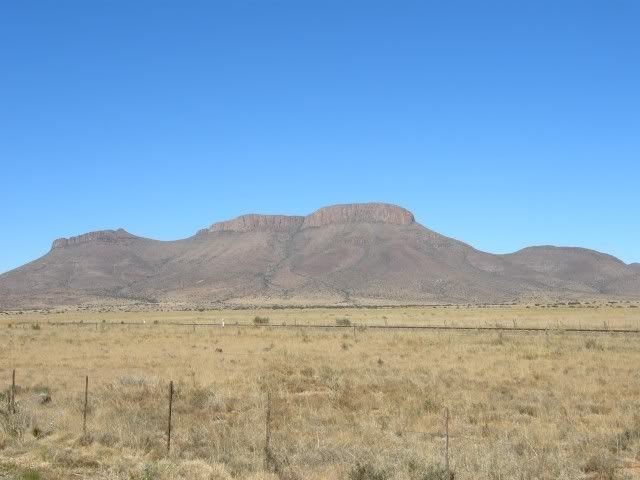

This is a dry area, but this pass has been closed several times before due to snow. Well, it is called the "Sneeuberge" after all

Great views over the Kamdeboo as you descend on the Southern side.

Then I got to the Nieu-Betesda turnoff. I remembered the guy I met on day 1 with the Harley. He wanted to go there but couldn't because his bike couldn't go on gravel. I just had to take the gravel. I phoned home again - "Uhm, I might not make lunch after all, but hope to be home for dinner"
It turned out to be a great decision!

Nieu-Betesda turned out to be one of those small town gems.

One horse town? Not quite.
Not quite.

The town is well looked after. The Post Office:

The Police station:

This guy's telephone number is 13

Almost all the stop streets look like this:

I can really see myself living in a town like this. It reminded me of the phrases in the song "Baker street" (by Gerry Rafferty):
The city desert makes you feel so cold,
It's got so many people but it's got no soul
And it's taken you so long to find out you were wrong
When you thought it held everything
He's got this dream about buyin' some land
And then he'll settle down
It's a quiet little town
And forget about everything


I wasn't the only biker looking around.

Nieu-Betesda was also the home of Helen Martins.
Helen Martins
Helen Martins was born in December 1897 and grew up in Nieu-Bethesda as the youngest of six children. She obtained a teachers diploma in nearby Graaff-Reinet and, around that time, married Johannes Pienaar; a teacher, dramatist and in later years a politician. The marriage did not last long and knowledge about her activities in the years that followed is sketchy and often contradictory.
Helen returned to Nieu-Bethesda in the nineteen-thirties to care for her ailing and elderly parents. After they died Helen Martins was left alone, with few prospects, in this remote Karoo village. It was some time after this, somewhere in her late forties or early fifties, that 'Miss Helen', as she became known, was to begin to transform her surroundings.
It is certain that Miss Helen sought praise and attention through her work but as time progressed, and derision and suspicion grew within the village, she became increasingly reclusive.
On a cold winters' morning in 1976, at the age of seventy-eight, Helen Martins,took her own life by swallowing caustic soda. It was her wish that her creation be preserved as a museum. And, her desire to be recognised as an artist is magnificently realised in the attention accorded to the Owl House and the fact that her artwork, once an object of derision and embarrassment, has become the single most important asset of the village of Nieu-Bethesda.
This village has so much to see, so much to offer. I cannot believe I wasted half a day in Middelburg

Owl House
Helen Martins lay ill in bed one night, with the moon shining in through the window, and considered how dull and grey her life had become. She resolved, there and then, that she would strive to bring light and colour into her life. That simple decision, to embellish her environment, was to grow into an obsessive urge to express her deepest feelings, her dreams and her desires.
The interior of the house was virtually completed before the exterior was begun. From the mundane articles that surrounded her, Miss Helen extracted and manipulated an emblematic language of sun-faces, owls and other images. She was particularly inspired by biblical texts, the poetry of Omar Khayyam, and the works of William Blake.
Her favourite animals, owls and camels, predominate, but all manner of real and fantastical beings are to be found. A procession of shepherds and wise men lead a vast, almost life-size camel train toward an 'East' as designated by Helen Martins, and integrates Christianity with her fascination for the Orient.
I took over a hundred photos here. This places is truly amazing. The whole inside of the house is decorated with glass - walls, ceilings, everything.

The house also has some interesting Antiques. I wish Mrs. TR could see this.
The back yard is filled with sculptures.



Trying to hold back time:

Next door to the Owl House there is a fossil museum. The whole district is rich in fossils.


All the roads leading to this town are gravel roads. I decided to take this gravel pass (Riverdene road) out of town and travel to Graaf Reinet on a round about way via the Ouberg Pass.

When I reached Graaf Reinet it was midday already.
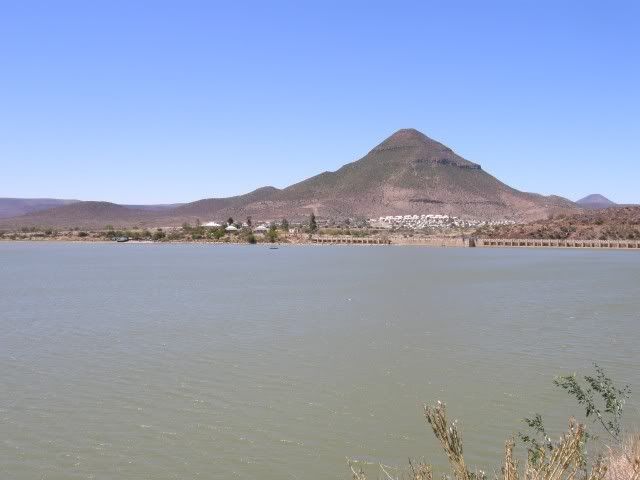
The town lies in the horse-shoe bend of the Sundays River and boasts more proclaimed national monuments than any other South African town. It lies in the middle of the Karoo National Reserve (15 000 ha) with another wonder of nature, the Valley of Desolation.

There is so much to see! Why oh why did I waste time in Middelburg
Graaf Reinet
Graaf-Reinet a small Karoo town in South Africa is today a tourist destination because of its history. Graaff-Reinet has much of its history preserved in its architecture one of the reasons Tourists flock to the area. Around 1770 the trek of the Boers had penetrated from the Cape into the area of todays Graaff-Reinet. Here, at the margin of the colony, they led an unsteady life under constant threat from Xhosa groups, but as independent and autonomous farmers.
This situation was too difficult for the Cape Town administration to inspect, so they decided to establish a state authority in the region. The first administrator was installed here in 1785. He determined the borders of his territory in 1786, had an administration building erected - the Drostdy - and named the place after the then Governor Jacob van der Graaff and his wife Cornelia Reinet.
The attempt to secure government authority turned out to be difficult. The self-assured citizens resisted any supervision. In 1795 they even proclaimed an autonomous republic, an endeavour which failed however, mainly due to the arrival of the English at the Cape that same year.
But the government also did not manage to establish lasting peace, and when at the end of the 19th century the Boer War broke out, the citizens of Graaff-Reinet fought fiercely on the side of the Boers. Nowadays Graaff-Reinet with its 200 monument-protected buildings is one of the best preserved historical places in the country.
Just look at this magnificent church:

The church was built at a cost of £18 000, using local sandstone which was quarried and dressed at Adendorp and conveyed over the 8+ km by oxwagon by the members of the congregation. The roof beams and trusses were prepared in Port Elizabeth and transported by oxwagon over 275 km to the site.
This photo was taken over a 100 years ago:

I have to come back. I will do so soon.
I left Graaf Reinet at 1pm with 385km to go to George.
Aberdeen:

Uniondale:

Coming down the Langkloof I could see that it would be cold and wet on the George side of the mountain.

I nevertheless decided to ride to George via the Montagu Pass. This is just outside of Herold riding back into the Southern Cape:

After 550km for the day the trip drew to a close and I literally had my head in the clouds. The view from the top of Montagu Pass:

What a great trip. Hopefully Mrs. TR and I will do something like this annually. The trip totaled 3400km at an average fuel consumption of 18.5 km/L
This country has so much to see. I hope to get back to Graaf Reinet soon and also visit the site of the Battle of Stormberg. Of all the towns Nieu-Betesda and Graaf Reinet impressed me the most, but the moment of the trip I'll never forget? Walking with Lions.
When I woke up this morning I knew the trip was over. I'm going home. I had to ride just over 480km and I phoned Mrs. TR and told her that I'd be home for lunch. The decision was made. It was time.
I was in high spirits as I rode through the Mid-Karoo.


This is a dry area, but this pass has been closed several times before due to snow. Well, it is called the "Sneeuberge" after all


Great views over the Kamdeboo as you descend on the Southern side.

Then I got to the Nieu-Betesda turnoff. I remembered the guy I met on day 1 with the Harley. He wanted to go there but couldn't because his bike couldn't go on gravel. I just had to take the gravel. I phoned home again - "Uhm, I might not make lunch after all, but hope to be home for dinner"

It turned out to be a great decision!

Nieu-Betesda turned out to be one of those small town gems.

One horse town?

The town is well looked after. The Post Office:

The Police station:

This guy's telephone number is 13

Almost all the stop streets look like this:

I can really see myself living in a town like this. It reminded me of the phrases in the song "Baker street" (by Gerry Rafferty):
The city desert makes you feel so cold,
It's got so many people but it's got no soul
And it's taken you so long to find out you were wrong
When you thought it held everything
He's got this dream about buyin' some land
And then he'll settle down
It's a quiet little town
And forget about everything


I wasn't the only biker looking around.

Nieu-Betesda was also the home of Helen Martins.
Helen Martins
Helen Martins was born in December 1897 and grew up in Nieu-Bethesda as the youngest of six children. She obtained a teachers diploma in nearby Graaff-Reinet and, around that time, married Johannes Pienaar; a teacher, dramatist and in later years a politician. The marriage did not last long and knowledge about her activities in the years that followed is sketchy and often contradictory.
Helen returned to Nieu-Bethesda in the nineteen-thirties to care for her ailing and elderly parents. After they died Helen Martins was left alone, with few prospects, in this remote Karoo village. It was some time after this, somewhere in her late forties or early fifties, that 'Miss Helen', as she became known, was to begin to transform her surroundings.
It is certain that Miss Helen sought praise and attention through her work but as time progressed, and derision and suspicion grew within the village, she became increasingly reclusive.
On a cold winters' morning in 1976, at the age of seventy-eight, Helen Martins,took her own life by swallowing caustic soda. It was her wish that her creation be preserved as a museum. And, her desire to be recognised as an artist is magnificently realised in the attention accorded to the Owl House and the fact that her artwork, once an object of derision and embarrassment, has become the single most important asset of the village of Nieu-Bethesda.
This village has so much to see, so much to offer. I cannot believe I wasted half a day in Middelburg


Owl House
Helen Martins lay ill in bed one night, with the moon shining in through the window, and considered how dull and grey her life had become. She resolved, there and then, that she would strive to bring light and colour into her life. That simple decision, to embellish her environment, was to grow into an obsessive urge to express her deepest feelings, her dreams and her desires.
The interior of the house was virtually completed before the exterior was begun. From the mundane articles that surrounded her, Miss Helen extracted and manipulated an emblematic language of sun-faces, owls and other images. She was particularly inspired by biblical texts, the poetry of Omar Khayyam, and the works of William Blake.
Her favourite animals, owls and camels, predominate, but all manner of real and fantastical beings are to be found. A procession of shepherds and wise men lead a vast, almost life-size camel train toward an 'East' as designated by Helen Martins, and integrates Christianity with her fascination for the Orient.
I took over a hundred photos here. This places is truly amazing. The whole inside of the house is decorated with glass - walls, ceilings, everything.

The house also has some interesting Antiques. I wish Mrs. TR could see this.
The back yard is filled with sculptures.



Trying to hold back time:

Next door to the Owl House there is a fossil museum. The whole district is rich in fossils.


All the roads leading to this town are gravel roads. I decided to take this gravel pass (Riverdene road) out of town and travel to Graaf Reinet on a round about way via the Ouberg Pass.

When I reached Graaf Reinet it was midday already.

The town lies in the horse-shoe bend of the Sundays River and boasts more proclaimed national monuments than any other South African town. It lies in the middle of the Karoo National Reserve (15 000 ha) with another wonder of nature, the Valley of Desolation.

There is so much to see! Why oh why did I waste time in Middelburg

Graaf Reinet
Graaf-Reinet a small Karoo town in South Africa is today a tourist destination because of its history. Graaff-Reinet has much of its history preserved in its architecture one of the reasons Tourists flock to the area. Around 1770 the trek of the Boers had penetrated from the Cape into the area of todays Graaff-Reinet. Here, at the margin of the colony, they led an unsteady life under constant threat from Xhosa groups, but as independent and autonomous farmers.
This situation was too difficult for the Cape Town administration to inspect, so they decided to establish a state authority in the region. The first administrator was installed here in 1785. He determined the borders of his territory in 1786, had an administration building erected - the Drostdy - and named the place after the then Governor Jacob van der Graaff and his wife Cornelia Reinet.
The attempt to secure government authority turned out to be difficult. The self-assured citizens resisted any supervision. In 1795 they even proclaimed an autonomous republic, an endeavour which failed however, mainly due to the arrival of the English at the Cape that same year.
But the government also did not manage to establish lasting peace, and when at the end of the 19th century the Boer War broke out, the citizens of Graaff-Reinet fought fiercely on the side of the Boers. Nowadays Graaff-Reinet with its 200 monument-protected buildings is one of the best preserved historical places in the country.
Just look at this magnificent church:

The church was built at a cost of £18 000, using local sandstone which was quarried and dressed at Adendorp and conveyed over the 8+ km by oxwagon by the members of the congregation. The roof beams and trusses were prepared in Port Elizabeth and transported by oxwagon over 275 km to the site.
This photo was taken over a 100 years ago:

I have to come back. I will do so soon.
I left Graaf Reinet at 1pm with 385km to go to George.
Aberdeen:

Uniondale:

Coming down the Langkloof I could see that it would be cold and wet on the George side of the mountain.

I nevertheless decided to ride to George via the Montagu Pass. This is just outside of Herold riding back into the Southern Cape:

After 550km for the day the trip drew to a close and I literally had my head in the clouds. The view from the top of Montagu Pass:

What a great trip. Hopefully Mrs. TR and I will do something like this annually. The trip totaled 3400km at an average fuel consumption of 18.5 km/L
This country has so much to see. I hope to get back to Graaf Reinet soon and also visit the site of the Battle of Stormberg. Of all the towns Nieu-Betesda and Graaf Reinet impressed me the most, but the moment of the trip I'll never forget? Walking with Lions.
2 comments:
Ongelooflike toer deur ons land, dankie vir die moeite wat julle gedoen het om julle avontuur met my en nog vele meer avontuurlistiges te deel!
Ek het sopas +/- 4000 km toer afgele van die Kaap na Johannesburg en terug, via die Noord Kaap, op my Honda VFR750, was ongelukkig ook beperk tot die teer paaie, maar ek beplan om binnekort vir my iets soortgelyks aan die Trans Alp aan te skaf en dan weer die pad te vat deur ons ongelooflike land. Ek het sommer 'n klomp goeie bestemmings geidentifiseer te danke aan die "Love & War Tour", baie dankie.
Absolutely wonderful and you are a good photographer. Pieter
Post a Comment